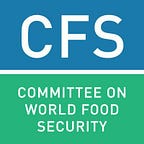What can farmers do to adapt to climate change?
How our food producers can stay productive in changing times
As the dust settles following COP 22 in Marakesh, more than 110 Parties have ratified the Paris Agreement, a key sign of moving beyond commitment, towards concrete action. Climate change is already affecting the lives of people all over the world in many different ways but food producers in particular will face many challenges and will have to adapt so that they can continue to produce healthy, safe food for us to eat, while reducing emission intensity. Although individual farmers face specific challenges, there are some recurring themes that most food producers are facing.
Change varieties, species and systems
Diversifying can hedge against risks in the face of greater weather variability and integrating different systems could improve resilience as some species are more tolerant of different environmental conditions than others. The use of currently neglected or rare crops or breeds could be part of the solution. Farmers could plant different varieties or species of crops or rear different breeds of livestock, fish or aquaculture. They also could sow crops — including feedstock and forage — at different times of the year and alter their traditional practices to take advantage of differing weather patterns.
Conserving water for the bread baskets
In many places the major challenge will be producing with less or too much water either from reduced rainfall or more rain in extreme weather events making it harder to capture. River flows may change as glaciers retreat and there could be more competition for water as the weather gets hotter. These water challenges may be particularly critical in some of the major bread basket regions of the world which provide staple crops for large populations. Food producers will need to look at ways to conserve water and make more use of rain water harvesting and capture. On the other hand, in some areas more rainfall may allow crops to be grown — either irrigated or rain fed — in places where it wasn’t possible before.
Change agronomic practices
Changes in rainfall could mean less ploughing to reduce the amount of water lost and using more manure and compost as well as cover crops to increase soil organic matter and improve water retention. Animal stocks and their diets will need to respond to changing environmental conditions. More big storms will create a need for better drainage and farms designed to avoid soil loss and the creation of gullies. Improved soil organic matter will help retain water after storms. Farms in coastal areas may need to adapt to more saltwater intrusions and those in dry areas, more frequent wild fires.
Pests, weeds and diseases
The enemies of food crops — pests, weeds and diseases — will respond differently to climate change, not always with negative effects for food producers, but the usual coping strategies of farmers may be disrupted. Drying and storage practices of grain crops may need to change to keep these crops edible as the climate changes. There may be disruption of the pollination eco system farmers rely on, such as bees.
The way forward
The Paris Agreement reached in 2015, recognized by world leaders as a historic achievement, makes specific reference to the particular vulnerabilities of food production systems to the adverse impacts of climate change; and to the importance of protecting food production while reducing emissions.
Food producers can’t cope with the impact of climate change on their own. They need help from their governments.
In 2012 the 136 countries that belong to the Committee on World Food Security endorsed a set of policy recommendations on Food Security and Climate Change designed to ensure that food production continues sustainably as the climate changes. Putting these policies into practice will help our food producers adapt to unavoidable climate change, which is what we all want.
The Committee on World Food Security (CFS) is leading multi-stakeholder platform for food security and nutrition policy guidance. This article is based on the CFS High Level Panel of Experts on Food Security and Nutrition report on Food Security and Climate Change produced in 2012. At CFS 39 a set of policy recommendations on Food Security and Climate Change were endorsed by the Committee. These policy recommendations can be used by any stakeholders.
